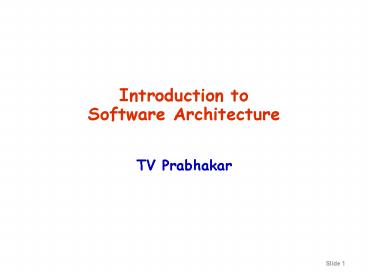Introduction to Software Architecture - PowerPoint PPT Presentation
Title:
Introduction to Software Architecture
Description:
Functionality is largely orthogonal to quality attribute requirements. ... Kruchten, Rational Software, Architectural Blueprints - The 4 1 View Model ... – PowerPoint PPT presentation
Number of Views:65
Avg rating:3.0/5.0
Title: Introduction to Software Architecture
1
Introduction toSoftware Architecture
- TV Prabhakar
2
Antecedents of Software Architecture
3
What is Software Architecture?
- 150 definitions
- What are they?
- Both a process and a product
4
(No Transcript)
5
(No Transcript)
6
(No Transcript)
7
(No Transcript)
8
(No Transcript)
9
(No Transcript)
10
What type of requirements drive architectural
design?
- Answer Quality attribute requirements are the
primary drivers for architecture design. - Do you agree?
11
(No Transcript)
12
(No Transcript)
13
Architecture and Functionality
- Functionality is largely orthogonal to quality
attribute requirements. - Functionality is the ability of a system to do
the work it was intended to do. - Systems are decomposed into elements to achieve a
variety of purposes other than function. - Architectural choices promote certain qualities
as well as implement the desired functionality.
14
Effects of Architectural Decisionson Quality
Attributes
- The degree to which a system meets its quality
attribute requirements is dependent on
architectural decisions. - A change in structure improving one quality often
affects the other qualities. - Architecture is critical to the realization of
quality attributes. - These product qualities should be designed into
the - architecture.
- Architecture can only permit, not guarantee, any
quality attribute.
15
Architecture-centric development?
- Architecture-centric development involves
- Creating the business case for the system
- Understanding the requirements
- Creating or selecting the architecture
- Documenting and communicating the architecture
- Analyzing or evaluating the architecture
- Implementing the system based on the architecture
- Ensuring that the implementation conforms to the
architecture - Maintaining the architecture
- The architecture must be both prescriptive and
descriptive.
16
(No Transcript)
17
(No Transcript)
18
(No Transcript)
19
(No Transcript)
20
(No Transcript)
21
(No Transcript)
22
Attribute-Driven Design
- The Attribute-Driven Design (ADD) method,
developed at the SEI, is an approach to defining
a software architecture that bases the
decomposition process on the quality attributes
the software must fill. - a recursive decomposition process where, at each
stage in the decomposition, tactics and
architectural patterns are chosen to satisfy a
set of quality scenarios.
23
(No Transcript)
24
ADD Method's Inputs and Outputs
- Inputs
- constraints
- functional requirements
- quality attribute requirements
- Outputs
- first several levels of module decomposition
- various other views of the system as appropriate
- set of elements for functionality and the
interactions among them
25
Architecture Documentation
- Architecture documentation is important if and
only if communication of the architecture is
important. - How can an architecture be used if it cannot be
understood? - How can it be understood if it cannot be
communicated? - Documenting the architecture is the crowning step
to creating it. - Documentation speaks for the architect, today and
20 years from today.
26
(No Transcript)
27
Issues Addressed byan Architectural Design
- Gross decomposition of a system into interacting
components - typically hierarchical
- using rich abstractions for component
interaction(or system glue) - often using common design idioms/styles
- Emergent system properties
- performance, throughput, latencies
- reliability, security, fault tolerance,
evolvability - Rationale and assignment of function to
components - relates requirements and implementations
- Envelope of allowed change
- load-bearing walls, limits of scalability and
adaptation - design idioms and styles
28
Schools of Thought
- 4 1 View
- Zachmann Framework
- RM - ODP
- IEEE
- OMG
- TOGAF
- Product Lines
29
4 1 view
- Philips Kruchten, Rational Software,
Architectural Blueprints - The 41 View Model of
Software Archtecture, IEEE Software, 1995 - Use case view
- Logical view
- Process view
- Implementation view
- Deployment view
30
41 view
31
What do the views do?
- logical view is the object model of the design
(when an object-oriented design method is used), - process view captures the concurrency and
synchronization aspects of the design, - physical view which describes the mapping(s) of
the software onto the hardware and reflects its
distributed aspect, - development view describes the static
organization of the software in its development
environment - illustrated by a few selected use cases, or
scenarios
32
Taxonomy of Styles
- Data Flow
- Batch Sequential
- Dataflow Network(pipes filters)
- acyclic, fanout, pipeline, Unix
- Closed loop control
- Call-and-return
- Main program/subroutines
- Information hiding(ADT, Object naïve
client/server)
33
Taxonomy..
- Interacting Processes
- LW processes, distributed objects
- Event systems
- implicit invocation, pure events
- Data-oriented repository
- Transactional databases
- True client/server
- Blackboard
- Modern compiler
34
Taxonomy..
- Data-sharing
- compound documents
- Hypertext
- Fortran COMMON
- LW processes
- Hierarchical
- Layered
- Interpreter
35
(No Transcript)
36
(No Transcript)
37
(No Transcript)
38
(No Transcript)
39
(No Transcript)
40
Architectural Styles
- An architectural style consists of
- component/connector types, topology
- constraints on the topology and behavior
- an informal description of the costs and benefits
of the style, e.g. use the pipe and filter style
when reuse is desired and performance is not a
top priority
41
Styles, Patterns and Idioms
- POSA, Buschmann etal
- GOF
42
References
- sei.cmu.edu
- IEEE
- OMG
- POSA
- GOF
- WWISA
- www.cetus-links.org
- Bredemeyer.com













![Top 5 Software Development Companies in New Zealand [Expert Views] PowerPoint PPT Presentation](https://s3.amazonaws.com/images.powershow.com/9607782.th0.jpg?_=20210531052)

















